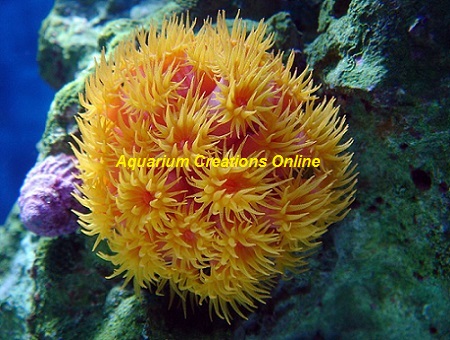The Orange Sun Polyp Coral, Orange Tubastrea is found on reef ledges or steep reef slopes. It is a colonial coral with a rich sunny yellow coloration when open and its central skeleton is round with tubes branching off in all directions. Orange Tubastrea is one of the most photographed corals in the world. This is not without reason. The brilliant orange coral issues forth lovely yellow orange tentacles at night, and is a sight that almost defies description. The polyps are large and extend mostly at night, although well fed and/or trained polyps may emerge during the day as well, especially if food is present. In the wild, the Tubastrea Coral is found on reef ledges or steep reef slopes. It is a colonial coral with a rich sunny yellow coloration when open and its central skeleton is round with tubes branching off in all directions. The Orange Tubastrea is moderate to maintain in the reef aquarium and makes an excellent coral choice for the beginner to advanced hobbyist.
Difficulty Moderate
Aggressiveness Despite the large polyp size, sun corals aren’t aggressive but avoid placing them near other corals which can sting them — especially LPS species and their potent sweeper tentacles.
Water-flow
Sun corals naturally inhabit areas of moderate to high flow and this needs to be replicated in the reef tank. Adequate flow brings food to the polyps as well as supplying oxygen and keeping animal tissue clean, ridding it of mucous and detritus.
Lighting
Low lighting is preferred (if a Par meter is available a Par level from 20 to 30).
Placement
They can be sited in areas of low lighting and, bearing in mind that sun corals are often found in caves or overhangs, specimens can also be placed upside down! Being suspended not only lends them a natural look but helps to prevent the accumulation of detritus and sand which can lead to tissue damage. The potential for accumulated sand to harm Tubastrea corals means that a sand bed site is risky.
Diet and Feeding
This coral does not have any symbiotic algae residing within its tissue therefore it is 100% dependent upon direct target feeding. It is important to feed your Sun Coral 3 to 4 times a week and provide a delicate diet mixture of mysis shrimp (just the liquid from the shrimp) no actual shrimp, fish eggs, and sea food morsels. Ideally, one should defrost the mysis shrimp in saltwater and then using a turkey baster gently blow the liquid around the Sun Coral. By providing your Sun Coral a consistent diet, you should see your coral thriving in no time. For continued good health, calcium, strontium, and other trace elements should be added to the water.
Reproduction
The Sun coral may reproduce by budding — forming tiny replicates of itself which eventually drop from the parent colony. It’s possible to ‘frag’ (fragment, or divide) a colony. Use a small Dremal tool to cut sections. However, try to minimise damage to the polyps themselves when fragging a specimen, initially separating them with a craft knife prior to dividing the colony.
|



